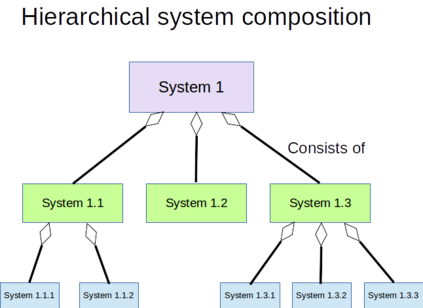In this paper I elaborated on the idea of David Harel and Amir Pnueli to think systems and their interaction from the point of view of their compositional behaviour. The obvious idea to base the composition of systems on the concept of computable functions and their compositional behaviour leads to supersystem formation by composing simple and recursive systems. But this approach does not allow to account adequately for systems that interact with many other systems in a stateful and nondeterministic way, which is why I introduce the concept of interactivity and cooperation. In order to describe interactive systems satisfactorily, a balance is needed between the representation of their relationship to all the other systems and what happens within the systems. I thus introduce the complementary descriptions of external interactions and internal coordination, both based on a role concept in the sense of a projection of a system onto its interactions. It actually mirrors the internal vs. external distinction initially introduced by the system model and reflects the problem how systems are supposed to cooperate without melting into a common supersystem. Components become systems, intended for (a given) composition and with the notion of an interface we subsume all relevant information necessary for this composition. I introduce the concept of decisions as an additional internal input alphabet in order to determine nondeterministic interactions and thus fictitiously assume a system function where we actually do not have the knowledge to do so. Thus, the close relationship between protocols and games becomes obvious. Finally, I transfer the gained insights to the field of IT system architecture and introduce the concept of the "interaction oriented architecture (IOA)" for interactive systems with its three elements of roles, coordination rules, and decisions.
翻译:在本文中,我阐述了David Harel和Amir Pnueli的想法,即从组成行为的角度来思考互动系统及其相互作用。从可计算功能的概念及其组成行为的角度出发,系统构成的明显想法是建立在可计算函数的概念及其组成行为的概念基础上的,这导致通过形成简单和循环的系统来形成超级系统。但是,这种方法无法充分说明与许多其他系统互动的系统以明确和非决定性的方式进行解释的系统,这就是为什么我引入互动与合作的概念。为了令人满意地描述互动系统与所有其他系统的关系和系统内部发生的情况之间需要平衡。因此,我引入对外部互动和内部协调的互补描述,两者都是基于一种角色概念,即一个系统对其互动的预测。它实际上反映了最初由系统模型引入的外部区别,反映了系统如何在不融化为共同的超级系统的情况下进行合作的问题。组成部分变成系统,是为了(给定)组成和我们为这一构成所必要的所有相关信息的界面的概念之间需要一种平衡的平衡。我引入了外部相互作用和内部协调的描述,因此,我引入了一种解释性决定的概念,从而成为了一种新的结构,从而成为了一种额外的结构,从而成为了一种额外的结构。
































